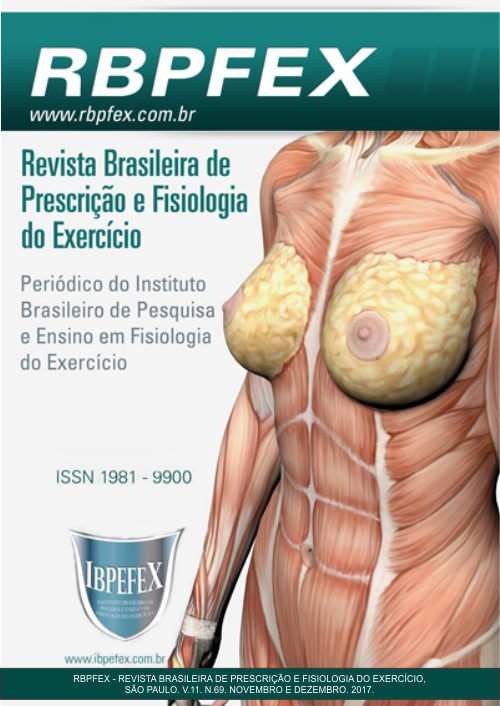Comparison of aerobic training before and after training resisted for the reduction of percentage of fat in young women initiating in musculation
Abstract
Introduction: According to the World Health Organization, in 2025 there will be 2.3 billion overweight and 700 million obese people. A sedentary lifestyle is a major factor for this increase. Objective: To compare the difference between performing aerobic training before and after resistance training to reduce the percentage of body fat in young women. Materials and methods: 14 women participated in this study, mean age 20.7 ± 3.0 years, BMI 27.1 ± 3.55 km / m² with fat percentage 30.0 ± 2.82. The women were divided into two groups that performed 20 minutes of running with Interval intensity before (TRAA) and after (TRDA) from a protocol of eight exercises against resistance for 12 weeks. Also lactate samples were taken at different sessions. Results: In TRAA group, there was an increase of 0.3kg in total body mass, decreased by 2.09% fat percentage (P> 0.12) equivalent to a loss of 0,69kg adipose tissue and increased 2,61kg of muscle mass. All values without significant differences. In TRDA group 0,29kg there was increase in total body mass, fat percentage decreased 1.24% (p> 0.34), in kilograms, 0,94kg, and muscle mass increased 1,71kg between final evaluation and initial. Conclusion: It is concluded that there was no significant difference between the two groups in the percentage of body fat (p> 0.27) between the initial and final evaluations of the experimental protocol, but there was an increase in muscle mass.
References
-American College of Sports Medicine. A quantidade e o tipo recomendados de exercícios para o desenvolvimento e a manutenção da aptidão cardiorrespiratória e muscular em adultos saudáveis. Revista Brasileira de Medicina do Esporte. Vol. 4. Núm. 3. p. 96-106. 1998.
-Arruda, D.P.; Assumpção, C. O.; Urtado, C. B.; Dorta, L. N. O.; Rosa, M. R. R.; Zabaglia, R.; de Souza, T. M. F. Relação entre treinamento de força e redução do peso corporal. Revista Brasileira de Prescrição e Fisiologia do Exercício. Vol. 4. Núm. 24. p. 605-609. 2010. Disponível em: <http://www.rbpfex.com.br/index.php/rbpfex/article/view/291/293>
-Domingues, F. L. A. Obesidade & atividade física. Jundiai. Fontoura. 2000.
-Dorneles, G. P.; Sant’Anna,M. M.; da Silva,R. N.; de Lemos,L. S.; Cassales, M. H.; Medeiros, F. M.; Peres, A.; Ribeiro, J. L. Comparação das respostas de frequência cardíaca e concentrações de lactato entre dois métodos de treinamento de musculação. Revista Brasileira de Prescrição e Fisiologia do Exercício. Vol. 6. Núm. 34. p. 379-387. 2012. Disponível em: <http://www.rbpfex.com.br/index.php/rbpfex/article/view/431/422>
-Fisiologia do exercício. Brasília. Fundação Vale. UNESCO. 2013. p.74. Cadernos de referência de esporte 2.
-Gentil, P. Emagrecimento: quebrando mitos e paradigmas. 3ª edição. 2014
-Gueths, M. As características e prescrições de um exercício aeróbico. Revista digital EfDeportes. Buenos Aires. Vol. 9. Núm. 67. 2003.
-Kang, J.; Ratamess, N. Wich comes first? Resistence before aerobic excersise or virce versa? ACSM’s Health & Fitness Journal. Vol. 18. Núm. 1. 2014.
-Kenney, W. L.; Wilmore, H. Jack.; Costill, L. David. Fisiologia do esporte e do exercício. Manole. 2013.
-Marins, J. C. B.; Giannichi, R. S. Avaliação e Prescrição de atividade física: guia prático. 2ª edição. Rio de Janeiro. Shape. 1998.
-Mancini, M.C. Obstáculos Diagnósticos e Desafios Terapêuticos no Paciente Obeso. Arquivo Brasileiro de Endocrinologia e Metabolismo. Vol. 45. Núm. 6. 2001.
-Mcardle, W. D; Katch, F. I; Katch, V. L. Nutrição para o desporto e o exercício. Rio de Janeiro. Guanabara Koogan. 2001.
-Mêneses, A.; e colaboradores. Validade das equações preditivas de uma repetição máxima varia de acordo com o exercício realizado em adultos jovens treinados. Revista Brasileira de Atividade Física e Saúde. Vol. 18. Núm. 1. p. 95-104. 2013.
-Miqueleto, B. C. Métodos de Avaliação e Controle da Composição Corporal por Meio de Exercícios Resistidos e Aeróbios. Monografia do curso de educação física. Universidade Estadual Paulista Júlio de Mesquita Filho. Bauru. 2011.
-Nascimento, M.G. B. Musculação, exercício aeróbico e suas relações com o emagrecimento. 2001. Dissertação de Pós-Graduação stricto Senso em educação física. Universidade Católica de Brasília.
-Oliveira, C. L.; Firsberg, M. Obesidade na Infância e Adolescência -Uma Verdadeira Epidemia. Abeso. Disponível em: <http://www.abeso.org.br/pdf/set/Ob%20infancia%20%20e%20adolescencia%20epidem.pdf>. Acesso em: 05/02/2015.
-OMS. Mapa da obesidade. Abeso. 2015. Disponível em: <http://www.abeso.org.br/atitude-saudavel/mapa-obesidade>. Acesso em: 13/05/2015.
-Pinto, L.C. Treinamento Concorrente: efeito da ordem dos exercícios sobre o dispêndio energético agudo. Monografia do curso de educação física. Universidade Federal do Rio Grande do Sul. Porto Alegre. 2011.
-Santarem, J. M. Exercícios resistidos. Treinamento resistido. Disponível em: <http://www.treinamentoresistido.com.br/tr/Pages/Articles/Article.aspx?ID=34>. Acesso em: 29/04/2015.
-Silva Filho, J. N. S. Treinamento de força e seus benefícios voltados para um emagrecimento saudável. Revista Brasileira de Prescrição e Fisiologia do Exercício. Vol. 7. Núm. 40. p. 329-338. 2013. Disponível em: <http://www.rbpfex.com.br/index.php/rbpfex/article/view/525/499>
-Viana, M. V.; Fernandes Filho, J.; Dantas, E. H. M.; Perez, A. J. Efeitos de um programa de exercícios físicos concorrentes sobre a massa muscular, a potência aeróbica e a composição corporal em adultos aeróbicos e anaeróbicos. Fitness and Performance Journal. Vol. 6. Núm. 3. p. 135-139. 2007.
Authors who publish in this journal agree to the following terms:
- Authors retain the copyright and grant the journal the right of first publication, with work simultaneously licensed under the Creative Commons Attribution License BY-NC which allows the sharing of the work with acknowledgment of the authorship of the work and initial publication in this journal.
- Authors are authorized to enter into additional contracts separately for non-exclusive distribution of the version of the work published in this journal (eg, publishing in institutional repository or book chapter), with acknowledgment of authorship and initial publication in this journal.
- Authors are allowed and encouraged to post and distribute their work online (eg, in institutional repositories or on their personal page) at any point before or during the editorial process, as this can bring about productive change as well as increase impact and impact. citation of published work (See The Effect of Free Access).






